Japan
Wood Products Prices
Dollar Exchange Rates of 25th
Sep
2024
Japan Yen 142.10
Reports From Japan
Business federation
welcomes new Prime Minister
Business leaders in Japan called on Shigeru Ishiba, the
newly elected president of the ruling Liberal Democratic
Party (and now Prime Minister) to accelerate economic
growth amid signs of recovery, including rising wages and
prices.
The newly appointed Prime Minister is expected to come
up with a stimulus package immediately. Masakazu
Tokura, chairman of the Japan Business Federation, the
country's biggest business lobby, described the new PM as
"a leader who is ready to propel innovations adding, our
country is facing a turning point to see if we can move out
of deflation completely" stressing that political and
economic stability is to realize growth”.
Speaking after being elected Ishiba said that he will follow
the same basic approach as former Prime Minister Fumio
Kishida's government in trying to pull Japan out of years
of deflation. "The economy won't improve if consumer
spending doesn't increase," he said.
Ishiba is also emphasising distribution of wealth to
workers and calling for the national average minimum
wage to rise to 1,500 yen per hour within this decade.
Corporate leaders upbeat on prospects
Corporate leaders in Japan are increasingly bullish about
the domestic economy as wage increases have started to
overtake the rise in inflation. The upbeat mood comes
from the expectation the consumer spending will rise.
According to a recent Nikkei survey more than 70% of top
business leaders in Japan say the economy is expanding
with most pointing to a recovery in consumer spending as
wages rise.
See: https://www.nippon.com/en/news/yjj2024092501042/japan-
2023-private-sector-pay-up-marginally-to-4-6-m-yen.html
Falling household spending holding back growth
After an economic rebound in the first half of 2023
Japan’s economy has since struggled. Real gross domestic
product fell 0.5% in the first quarter of 2024 from the
previous quarter and was down 1.3% from its peak in the
second quarter of 2023.
Most of the downturn was due to falling domestic
household spending which fell in three of the last four
quarters.
Analysis by the Deloitte Global Economics Research
Center published in its Japan Economic Outlook suggests
that stronger wage growth and more moderate inflation are
expected to boost consumer spending. In early 2024 the
weak currency drove export growth.
The report identifies that as the Bank of Japan tightens
monetary policy consumer spending and consequent
growth may be relatively modest.
In related news, the Ministry of Finance has reported a
trade deficit for a second straight month in August despite
signs of sluggish consumer spending that slowed imports.
Exports totaled 8.4 trillion yen (US$59 billion), up 5.6%
from the same month last year. Shipments to Asia rose
while exports to the US fell. Imports totaled 9.1 trillion
yen (US$64 billion), up 2.3% from a year earlier. By
region, imports from Europe showed the strongest growth.
Both numbers fell short of forecasts for 10% growth in
exports and an even higher increases for imports.
See: https://www2.deloitte.com/us/en/insights/economy/asia-
pacific/japan-economic-outlook.html
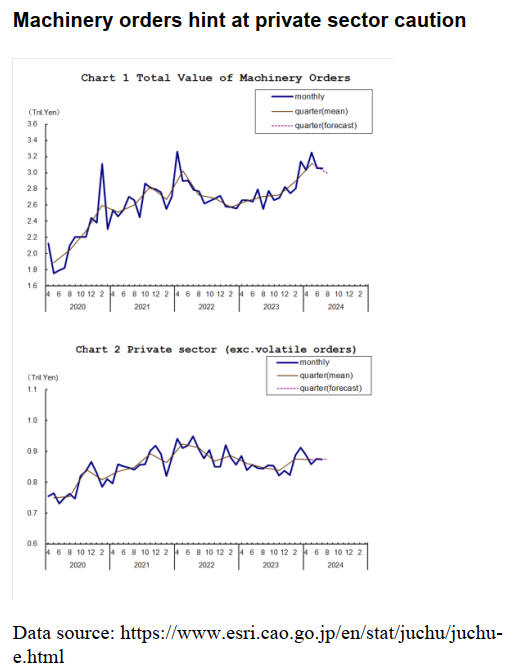
Seasonally adjusted July core machinery orders, an
indicator of business prospects, declined slightly from the
previous month according to a release from the Cabinet
Office. Private-sector orders, excluding those for ships and
power equipment, a closely watch leading indicator of
corporate capital spending, was little changed from June
when orders rose 2% month on month in June.
BoJ - inflation expectations have risen
At the Monetary Policy Meeting held 20 September the
Policy Board of the Bank of Japan assessed the economy
has recovered moderately, although some weakness has
been seen and overseas economies have grown moderately
on the whole. However exports and industrial production
have been more or less flat but with improved corporate
profits fixed investment has been rising.
The employment and income situation have improved and
there has been an uptick in private consumption despite
the impact of price rises but investment in housing
investment has been subdued.
The Bank says inflation expectations have risen
moderately and the economy is likely to keep growing at a
pace above its potential growth rate, with overseas
economies continuing to grow moderately and as a
virtuous cycle from income to spending gradually
intensifies against the background of factors such as
accommodative financial conditions.
Underlying CPI inflation is expected to increase gradually
since it is projected that the output gap will improve and
that medium to long-term inflation expectations will rise
in tandem with wages.
See: https://www.boj.or.jp/en/mopo/mpmdeci/mpr_2024/k240920a.pdf
Aging population has implications for house builders
Japanese aged 65 or older now account for nearly 30% of
the population. Data from the Ministry of Internal Affairs
and Communications shows Japan’s elderly population hit
36.25 million in 2023, a record high, with those aged 65 or
older now accounting for almost one-third, a higher
proportion than most other countries in the region. The
data also showed that a record 9.14 million elderly people
were employed last year, accounting for one in seven
employees.
Japan is grappling with a worsening demographic crisis as
a dwindling number of working-age people face being
saddled with mounting healthcare and welfare costs and
this will dampen the prospects for spending on
discretionary goods and has serious implications for the
housing market leading several Japanese house builders to
explore foreign market opportunities.
See: https://www.aljazeera.com/economy/2024/9/16/japans-
elderly-population-rises-to-record-36-25-million
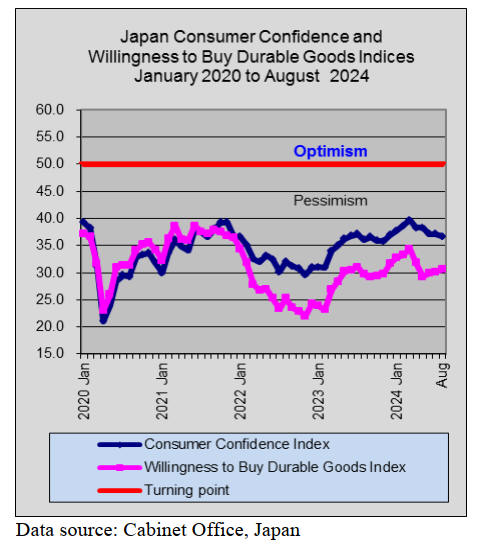
Japanese Yen exchange rate remains steady
The day before the Bank of Japan (BoJ) Policy Board
meeting Governor Kazuo Ueda said that the Bank has time
to evaluate market and economic conditions before
making any significant policy adjustments, which has been
interpreted as signaling no interest rate increases are
imminent.
He noted that Japan's real interest rate remains negative
which is helping to stimulate the economy and drive up
prices.
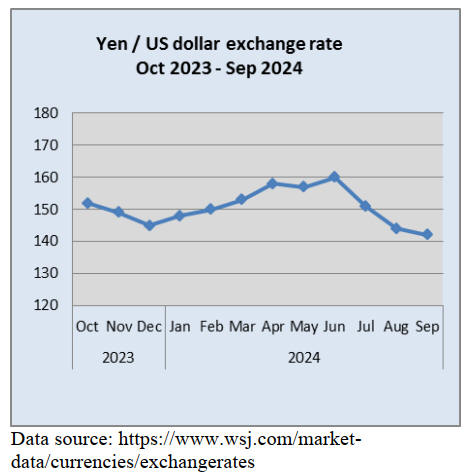
Weak yen attracted investment in real estate
Japan is enjoying an unexpectedly active property market
but some see risks ahead. The weak yen has attracted
investment in real estate which is beginning to drive up
prices.
The data from the Land Institute of Japan data shows
prices have been rising since the end of the pandemic with
prices in some areas close to a 20-year high. Inevitably,
there are worries this could trigger a housing market
crash.
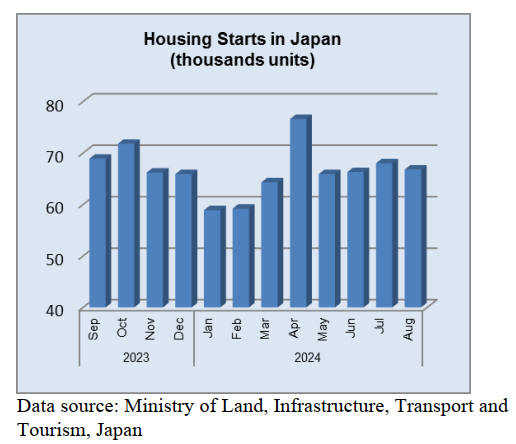
Recent Cabinet Office data shows house prices in July
rose by 2.8% year-on-year. While that’s a fraction of the
increases seen in the UK, the US and the EU it represents
the fastest price rise in Japan since 2014.
See: https://capital.com/en-au/analysis/japan-house-price-crash-
foreign-investment-weak-yen
Import update
Japan has plans to broaden antidumping duties to cover
products shipped through third countries.
At present duties apply only to products from spesified
countries of origin but do not cover goods that have been
modified slightly or reprocessed in third countries. New
regulations will be put in place to make it easier to
investigate suspected circumvention of trade restrictions
and duty avoidance.
See: https://asia.nikkei.com/Economy/Trade/Japan-to-expand-
antidumping-duties-to-fight-
evasion?utm_campaign=GL_JP_update&utm_medium=email&u
tm_source=NA_newsletter&utm_content=article_link
Assembled wooden flooring imports
June marked a reversal of the decline in the value of
assembled flooring imports (HS441871-79) which was
observed since April. The July data from the Ministry of
Finance shows the up-swing continued in July. Month on
month there was a 20% increase in the value of imports,
however, compared to July 2023, there was an 8% decline
in July this year.
The yen/US dollar exchange rate at the beginning of the
second half of the year was around yen 145 to the US
dollar, a marked strengthening from the level of 150-160
in the second quarter of this year and this strengthening
has given a boost to importers.
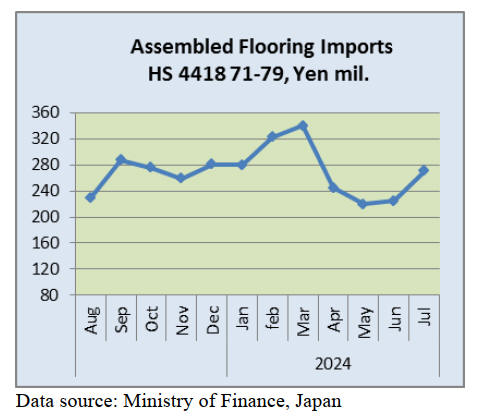
As in previous months the main category of assembled
flooring imports was HS441875, accounting for 70% of
the total value of assembled flooring imports, slightly
down from the previous month. The second largest
category in terms of value was HS441879 followed by
HS441874.
Shippers in China accounted for almost 70% of
Japan’s
imports of assembled wooden flooring in June with
shippers in Vietnam accounting for another 15%. Three
other countries shipped assembled flooring (HS441875) to
Japan in July, Germany, Denmark and Italy.
Plywood imports
Of the various categories of plywood imported in July
most was HS441231. Of total shipments from Malaysia
and Indonesia, over 90% was HS441239. Shipments from
China were more varied with HS441234 and 39
accounting for around 40% each of July shipments with
HS441231 accounting for most of the balance.
Shippers in Vietnam supplied mainly HS441231 (70%)
with HS441234 making up most of the balance. Other
shippers appearing in Japan’s plywood import statistics in
July included Finland, Latvia and Russia.
The volume of July plywood imports (441210-39) was
128,706 cu.m, up by over 20% from the same month in
2023 however, month on month the volume of July
shipments was little changed.
Year on year the volume of July arrivals from China,
Malaysia and Vietnam increased with July arrivals from
Indonesia being at around the same level as in June.
Import data shows that for the two main plywood suppliers
to Japan, Malaysia and Indonesia, July volumes were little
changed from the previous month.
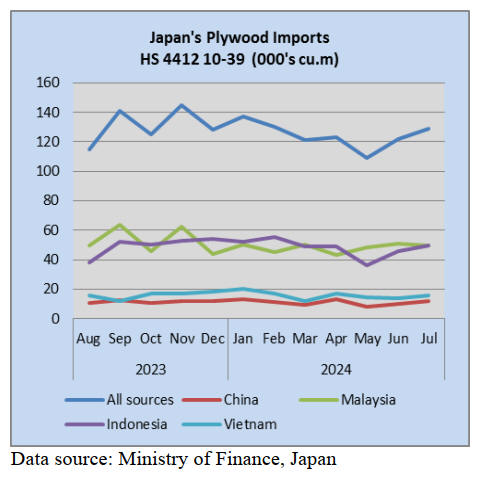
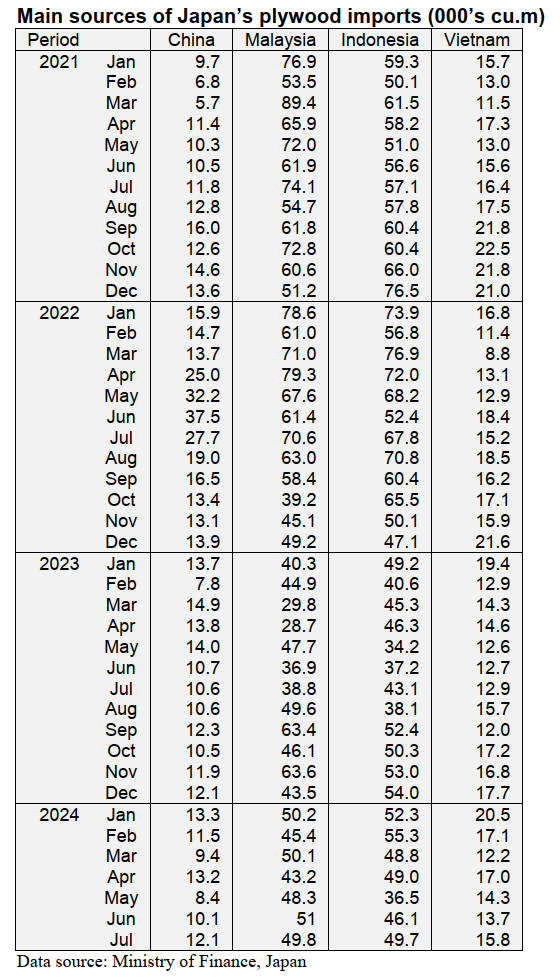
Trade news from the Japan Lumber Reports (JLR)
The Japan Lumber Reports (JLR), a subscription trade
journal published every two weeks in English, is
generously allowing the ITTO Tropical Timber Market
Report to reproduce news on the Japanese market
precisely as it appears in the JLR.
For the JLR report please see:
https://jfpj.jp/japan_lumber_reports/
Imports of European lumber
Volume of European softwood lumber in January to June
2024 is 981,000 cu.m, 24.5 % more than January to June,
2023. It seems that the volume of European softwood
lumber has increased from last year but the inventories,
which were overstocking last year, are less than last year
and the volume of European softwood lumber did not
reach 1,000,000 cu.m at the first half of this year.
Additionally, a shortage of European softwood lumber did
not occur. It could say that demand for European softwood
lumber has been declining.
Since there was a strike in Finland, a certain amount of
European softwood lumber arrived in Japan in July, 2024.
After August 2024, the arrival volume of European
softwood lumber will be the same volume as the first half
of this year or less than the volume at the first half of this
year.
Planed or polished stud are 362,124 cu.m, 24.2 % more
than the same period last year. Non - planed or polished
lamina is 615,242 cbms, 24.9 % more and non-planed or
polished tongue and groove joint is 3,656 cu.m, 6.3 % less
than the same period last year. Non-planed or polished
lumber made of pine is 409,577 cbms, 24.6 % more and
non-planed or polished lumber made of fir or spruce is
205,665 cu.m, 25.6 % more than the same period last year.
Several countries, which supply studs to Japan, have
exceeded the results in January to June 2023. Sweden,
which supplies studs to Japan the most, had a 3.7 %
decrease in supply volume from the same period last year.
Studs from Latvia increases 3.1 % up from the same
period last year. Austria is 6.2 % higher than the same
period last year.
For lamina, Austria is 33 % down and Estonia is 37.9 %
down from January to June 2023. Also, Latvia is 2.0 %
decreased. Finland is 4.2 % up.
Imports of wood fuel for 1st half of 2024
Volume of imported wood fuel at the first half of 2024 is
3,970,000 tonnes, 7.0 % less than the same period last
year. The volume of PKS decreased 30 % from the same
period last year but the volume of wood pellet is nearly
2,800,000 cbms at the first half of this year.
Imported wood fuel is used at large wood biomass power
plants and coal-fired power plants. However, some wood
biomass power plants have stopped operations due to the
fire and other accidents and it takes time to repair the
wood biomass power plants.
Since it is easier to get the certification of PKS than before
and supply of PKS started to increase. PKS does not burn
a lot of calories compared to wooden pellets. However, the
price of PKS was $130, FOB per ton before March 2024
and this is the reason for the decrease at the first half of
this year. Volume of PKS during January to June 2024 is
1,193,160 tonnes, 28.3 % down. Indonesian PKS is
884,303 tonnes, 29.6 % down. Malaysian PKS is 297,770
tonnes, 25.0 % down and Thai PKS is 11,087 tonnes, 6.3
% up.
Volume of wooden pellets at the first half of 2024 is
2,778,140 tonnes, 6.6 % increased from the same period
last year. Vietnamese wooden pellet is 1,398,322 tonnes,
19.9 % up.
Canadian wooden pellet is 523,389 tonnes, 28.2 % down.
American wooden pellet is 508,835 tonnes, 6.5 % down.
Indonesian wooden pellet is 149,976 tonnes, 348.0 % up.
Malaysian wooden pellet is 148,402 tonnes, 50.2 % up.
Wooden house business in Indonesia
Iida Group Holdings Co., Ltd. in Tokyo Prefecture, the
university of Bandung Institute of Technology in
Indonesia, Bogor Agricultural University in Indonesia and
The University of Tokyo agreed on a joint research about
spreading wooden houses in Indonesia. The joint research
had started for a new enterprise in 2027. They will develop
technical research and will also build a model home in the
universities in Indonesia.
There are a lot of forest resources in Indonesia and to
consume the local forest resources is one of their goals.
Usually, most houses in Indonesia are made of blocks or
bricks but the Indonesian government gropes for spreading
wooden houses. However, there is a problem which is
wood decay by termites.
Iida Group has been supplying houses in Okinawa, where
it is very hot and humid, and will provide its know-how
for the joint research. On the joint research, they will also
develop durability, quake resistance, maintenance system
and housing loan system.
South Sea logs and products
Movement of lumber for truck bodies is firm. However,
demand for other materials is low and the inquiries are a
few. Since the logs in South Asia are in short, South Asian
sellers do not sell the logs proactively. Japanese
distributors reduce the inventories. Then, some kinds of
lumber are in short. There were orders for large laminated-
boards before the holiday in the middle of August, 2024
due to the strong yen.
Some buyers were cautious to purchase products due to
the unclear movement in the future but some of buyers
purchased the products until October 2024. It is hard to
lower the price because the current products are purchased
in high price at the weak yen. Demand and supply for
South Sea log are balanced. South Sea logs are not in short
because a certain amount of South Sea logs had arrived in
Japan in July and August 2024.
Volume of composite wood flooring in 1st half of 2024
Production and sales volume of composite wood flooring
in January to June 2024 are below the results of January to
June 2023. The results of this year exceed the pace of
decline in new starts, which is 4.5 %, in the first half of
2024.
The ratio of specially processed sheet exceeds 70 % from
the same period last year. Since the prices of building
materials and of a house have skyrocketed, small houses
and single-story buildings are built. Therefore, floor areas
have been declining.
Production of composite wood flooring is 6.8 % less and
the sales volume is 7.7 % less than the same period last
year. The floor areas of new starts decrease 7.2 % down
from the first half of last year.
The production and the shipment of composite wood
flooring in every month in January to June 2024 did not
exceed the results in last year.
On the other hand, demand for sound proofing floors
are
firm. The production of LL45 is 945,000 tsubo, 4.2 %
more and the sales volume of LL45 is 950,000 tsubo, 2.8
% more than the same period last year. The reason for the
increase is that there were many apartment buildings were
built and the other reason is that people are more
interested in soundproofing floors than before COVID-19.
MDF and domestic plywood occupies 39 %, 2 points
down, of the sales volume. MDF and imported plywood
occupies 27 %, 2 points up. The imported plywood is 14
% and this is unchanged from the same period last year.
The sales volume of fancy boards is 23 %, 1 point down
and of specially processed sheet is 77 %, 1 point up from
the same period last year.
|